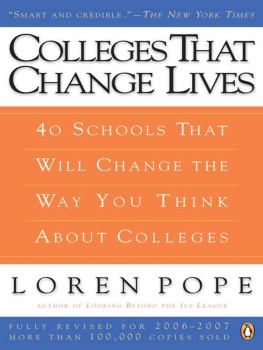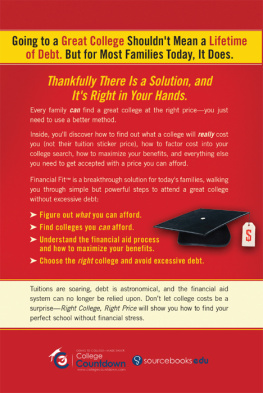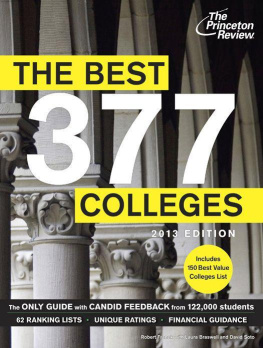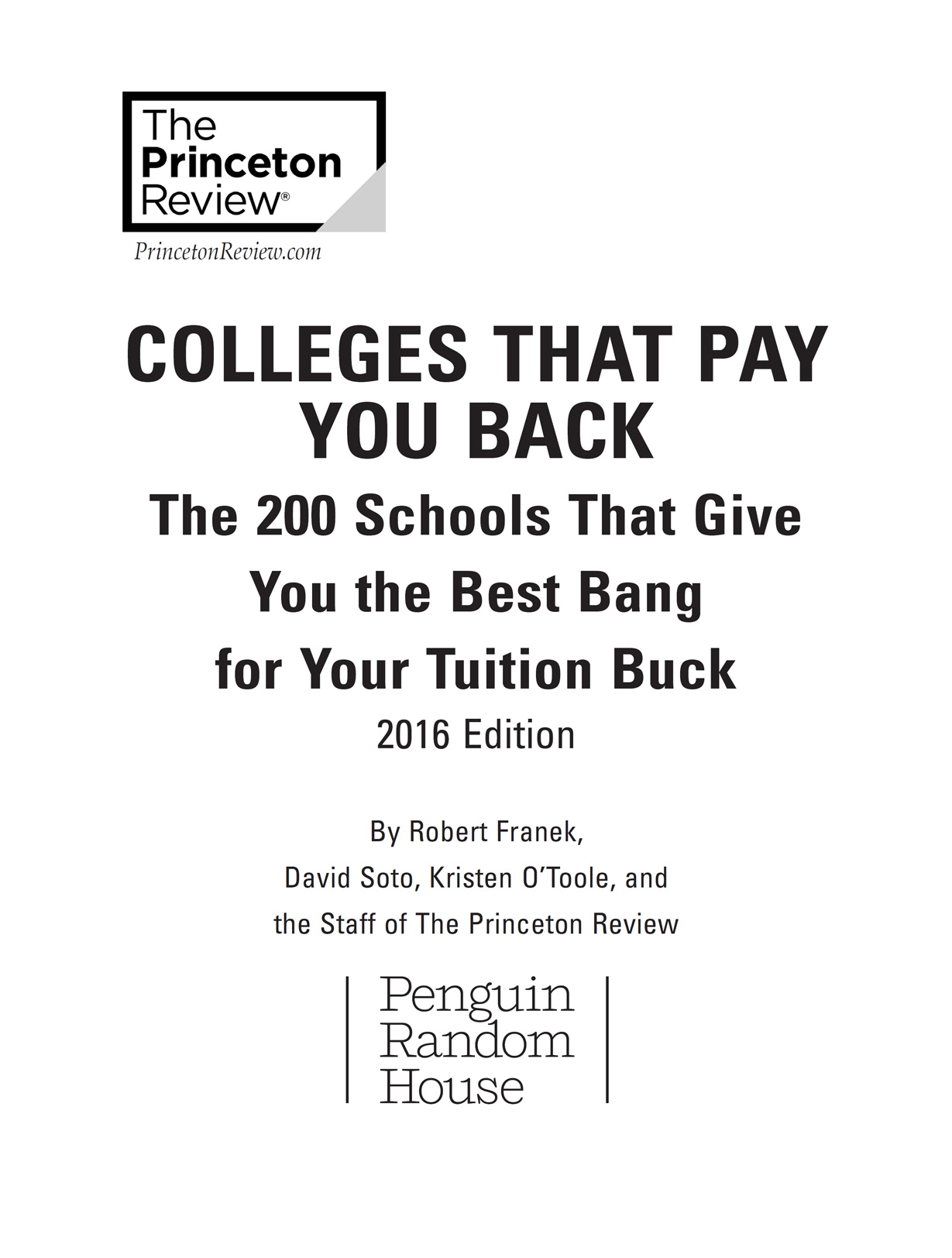Robert Franek, Senior VPPublisher David Soto, Director of Content Development Kristen OToole, Editorial Director Steven Koch, Student Survey Manager Pia Aliperti, Editor
Tom Russell, Publisher Alison Stoltzfus, Publishing Manager Ellen L. Reed, Production Manager Melinda Ackell, Managing Editor Kristin Lindner, Production Supervisor Andrea Lau, Designer The Princeton Review 24 Prime Parkway, Suite 201 Natick, MA 01760 2016 by TPR Education IP Holdings, LLC. Cover art Mindy Fawver / Alamy Stock Photo. All rights reserved. Published in the United States by Penguin Random House LLC, New York, and in Canada by Random House of Canada, a division of Penguin Random House Ltd., Toronto. All rankings, ratings, and listings are intellectual property of TPR Education Holdings, LLC.
No rankings, ratings, listings, or other proprietary information in this book may be repurposed, abridged, excerpted, combined with other data, or altered for reproduction in any way without express permission of TPR. eBook ISBN:9781101882474 Trade Paperback ISBN:9781101882467 Production: Best Content Solutions, LLC Production Editor: Melissa Duclos-Yourdon 2016 Edition v4.1 a
Introduction
The Princeton Review has long encouraged college applicants to seek out the schools that fit them best academically, culturally, and financially. As the cost of attending college continues to rise dramatically, applicants and their families are increasingly concerned about post-graduation job prospects. Tuition is an investment in the future, and like investors, students want to see a return on that investment. To continue our mission of helping students find the right college for them, we have combined alumni career outcome data with the institutional data and student surveys we collect to create a Return on Investment (ROI) rating for each of the 200 schools in this book. We know that students invest more than money in their educations, howeverthey invest their time, energy, and passion.
The ROI on your education is much more than a high salary.
History
In 2008, we began publishing Americas Best Value Colleges online (in partnership with USAToday), and in 2011, we turned that list into a book. The schools that we covered in
Best Value Colleges were chosen based on more than thirty factors covering three areas: academics, cost of attendance, and financial aid, including student ratings of their financial aid packages. The aim of our Best Value Colleges franchise was to highlight schools that offer excellent academics as well as excellent need and non-need-based aid.
How Does College Pay You Back?
Career outcomes have become as important to students and parents as academic quality and campus life when choosing a school. Increasingly, colleges and universities are moving their offices of career services closer to their admissions offices, providing visiting prospective students with a glimpse of what they can offer.
Career services advisors are engaging with students earlier in their time on campus, often in the first few weeks of their first year. These trends in career services arent a result of colleges pressuring students to plan out their futures before they are readyrather, colleges and universities are beginning to help students identify their interests, strengths, and passions, and use those to build the foundation of an effective long-term career strategy. In order to provide meaningful career metrics for each school profiled in this book, we partnered with PayScale.com, which surveys alumni about salary and career. On each of the 200 school profiles in Colleges That Pay You Back, youll find PayScale.coms median starting salary and mid-career salary for graduates of that school. To cover professions that have high social value but may offer lower salary numbers, such as teaching or non-profit management, we have also included the percentage of alumni who feel that their job makes the world a better place. All of these statistics are printed on each schools profile, and were incorporated into the overall ROI rating for each school.
When available, salary data is broken out for alumni who pursued further study, and the percentage of alumni with science/technology/engineering/math (STEM) majors is appears in some school profiles.
The Real Cost of College
When we set out to develop our ROI rating and determine which schools to include in this book, we started with the same cost analysis we used to create our Best Value Colleges criteria: We calculate the the sticker price of each college (often referred to as cost of attendance, that figure includes tuition, required fees and room and board), and subtract the average gift aid (scholarships and grants) awarded to students. We dont subtract work-study or student loans, since those are costs that students ultimately have to bear. Out of the 650 schools we considered for this project, the 200 we chose as our Colleges That Pay You Back offer great academics, combined with affordable cost, and stellar career outcomes.
Going Beyond Cold Hard Cash
Just as in our previous title
Best Value Colleges we defined value as inclusive of excellent academics, facilities, and on-campus resources in addition to generous financial aid packages, we believe colleges pay you back in more than a high salary. The colleges and universities that appear in this book were chosen based on more than forty factors.
These factors include PayScale.coms alumni career information, the cost of attendance, financial aid (based on both demonstrated need and merit), selectivity, academics, and student opinion surveys. This goes beyond the bottom line to provide a complete picture of a schools value, and as a result the 200 colleges that pay you back are diverse in academic programs, size, region, and type.
26 Tips for Getting Financial Aid, Scholarships, and Grants and for Paying Less for College
When it comes to actually paying for college, there is a lot of information out there. A great resource is our book
Paying for College Without Going Broke by Kalman Chany. Here, we have some tips from Kal for applying for financial aid and trimming the costs of college.
Getting financial aid
1.
Learn how financial aid works. The more and the sooner you know about how need-based aid eligibility is determined, the better you can take steps to maximize such eligibility. 2. Apply for financial aid no matter what your circumstances. Some merit-based aid can only be awarded if the applicant has submitted financial aid application forms. 3.
Dont wait until you are accepted to apply for financial aid. Do it when applying for admission. 4. Complete all the required aid applications. All students seeking aid must submit the FAFSA (Free Application for Federal Student Aid); other forms may also be required. 5. 5.
Get the best scores you can on the SAT or ACT. They are used not only in decisions for admission but they can also impact financial aid. If your scores and other stats exceed the schools admission criteria, you are likely to get a better aid package than a marginal applicant. 6. Apply strategically to colleges. (Check the Colleges That Pay You Back list and Financial Aid Ratings for schools in this book and on princetonreview.com.) 7. (Check the Colleges That Pay You Back list and Financial Aid Ratings for schools in this book and on princetonreview.com.) 7.








